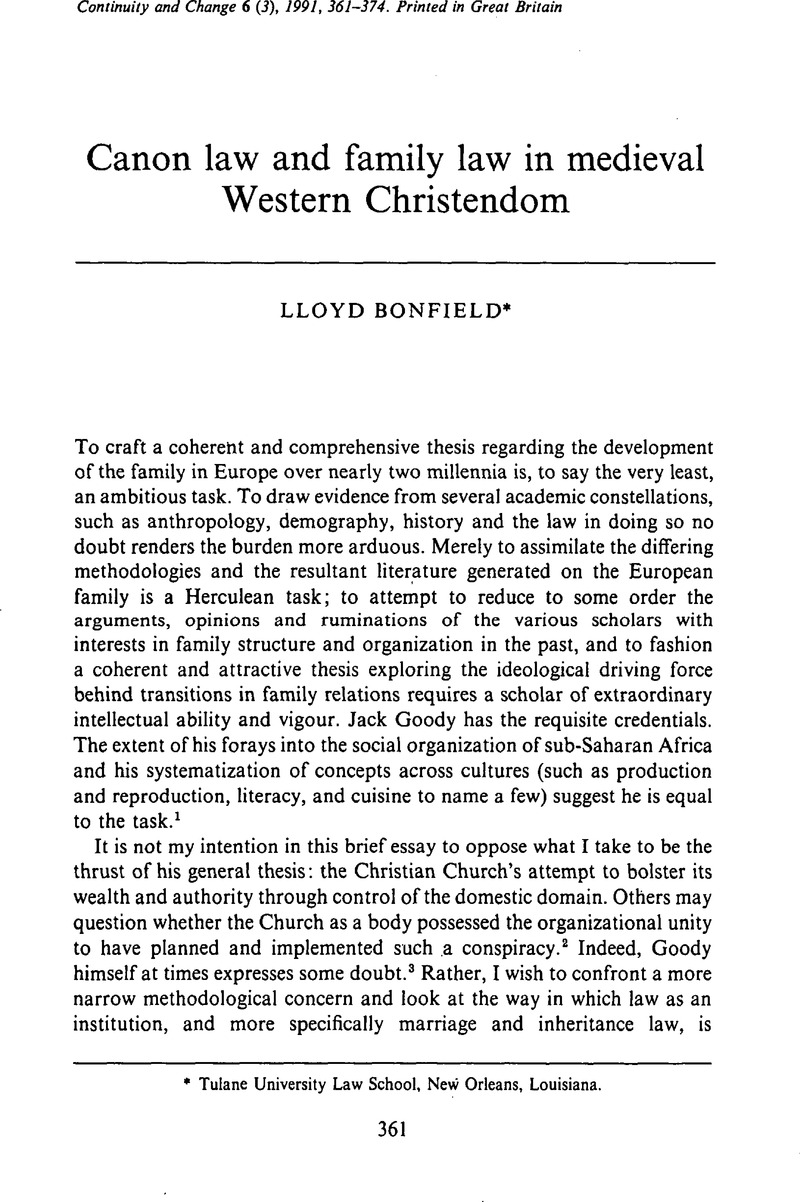Article contents
Canon law and family law in medieval Western Christendom
Published online by Cambridge University Press: 29 January 2009
Abstract

- Type
- Research Article
- Information
- Copyright
- Copyright © Cambridge University Press 1991
References
Endnotes
1 Production and reproduction (Cambridge, 1976)Google Scholar; The logic of writing and the organization of society (Cambridge, 1986)Google Scholar; Cooking, cuisine, and class: a study in comparative sociology (Cambridge, 1982).Google Scholar
2 In book reviews, both Sheehan, Michael (Catholic Historical Review, 73 (1987), 264–5)Google Scholar; and Houlbrooke, Ralph (English Historical Review, 99 (1984), 816–18)CrossRefGoogle Scholar intimate as much.
3 Goody, Jack, The development of the family and marriage in Europe (Cambridge, 1983), 215.CrossRefGoogle Scholar
4 Chapter 3 in particular.
5 Ibid., 37–47, 68–75.
6 Ibid., 36–42.
7 Ibid., 95–212.
8 Wrigley, E. A., ‘Fertility strategy for the individual and the group’, in Tilly, C., ed., Historical studies in changing fertility, 135–54.Google Scholar
9 Goody, The development of the family, 75.
10 Ibid., 42.
11 Brundage, James, Law, sex and Christian society in medieval Europe (Chicago, 1987).CrossRefGoogle Scholar
12 Ibid., 264–78, 331–7.
13 Goody, The development of the family, 35–6.
14 Duby, Georges, The knight, the lady and the priest: The making of modern marriage in medieval France (New York, 1983).Google Scholar
15 Ingram, Martin, Church courts, sex and marriage in England, 1570–1640 (Cambridge, 1987).Google Scholar
16 Brundage, Law, sex, and Christian society, 206–7, 297–300, 369–70, 444–7, 514–17.
17 Ibid., 141–4.
18 Drew, Katherine Fischer, trans., The Burgundian Code: Book of constitutions or law of Gundobad (Philadelphia, 1949), 86.Google Scholar
19 Ibid., 160.
20 Rivers, Theodore John, trans., Laws of the Alamans and Bavarians (Philadelphia, 1977), 79.Google Scholar
21 Scott, S. P., trans., The Visigothic code (Boston, 1910), 106.Google Scholar
22 Goody, The development of the family, 133–51.
23 See, for example, the family studies in Finch, M. E., The wealth of five Northamptonshire families, 1540–1640 (Northants Record Society, 1956).Google Scholar
24 Scott, trans., Visigothic code, 122.
25 Drew, Katherine Fischer, trans., The Lombard laws (Philadelphia, 1973), 188.Google Scholar
26 Baker, J. H., An introduction to English legal history, 3rd ed. (London, 1990), 558.Google Scholar
27 Millon, David, ‘Circumspecte agatis revisited’. Law and History Review, 2 (1984).CrossRefGoogle Scholar
28 Goody, The development of the family, 25.
29 Clark, Homer H., Jr., The law of domestic relations in the United States, 2nd ed. (St Paul, 1988), 850–2.Google Scholar
30 Goody, The development of the family in England, 99–101.
31 Ibid., 40.
32 Ibid., 196.
33 At least according to Tacitus.
34 Wrigley, ‘Fertility strategy’.
35 Scott, trans., Visigothic code, 121–3.
36 Drew, trans., Burgundian code, 77.
37 For example, Tardif, E.-J., ed., Coutumiers de Normandie (Rouen and Paris, 1903), 77–79Google Scholar; M. Planiol, ed., La très ancienne coutume de Bretagne (Rennes, 1896), 91–96.
38 Thorne, S. E., trans., Bracton on the laws and customs of England (Cambridge, Mass., 1968–1977), II, 188–201.Google Scholar
39 Wachter, Kennneth W. and Laslett, Peter, ‘Measuring patriline extinction for modeling social mobility in the past’ in Wachter, Kenneth W.et al., Statistical studies of historical social structure (New York, 1978), 113–36.CrossRefGoogle Scholar
40 For a discussion on alienation in medieval England, see Macfarlane, Alan, The origins of English individualism (Oxford, 1978)Google Scholar; the review by White, Stephen D. and Vann, Richard T., ‘The invention of English individualism: Alan Macfarlane and the modernization of pre-modern England’, Social History 8 (1983), 345–63CrossRefGoogle Scholar; and a comment by Poos, L. R. and Bonfield, Lloyd, ‘Law and individualism in medieval England’, Social History 11 (1986), 287–301.CrossRefGoogle Scholar
41 Tardif, ed., Coutumiers, 87; Planiol, ed., Coutume, 99–101.
42 Thorne, trans., Bracton, Vol. II, 186.
43 For example, Scott, trans., Visigothic code, 130.
44 Goody, The development of the family, 707–9.
- 4
- Cited by


